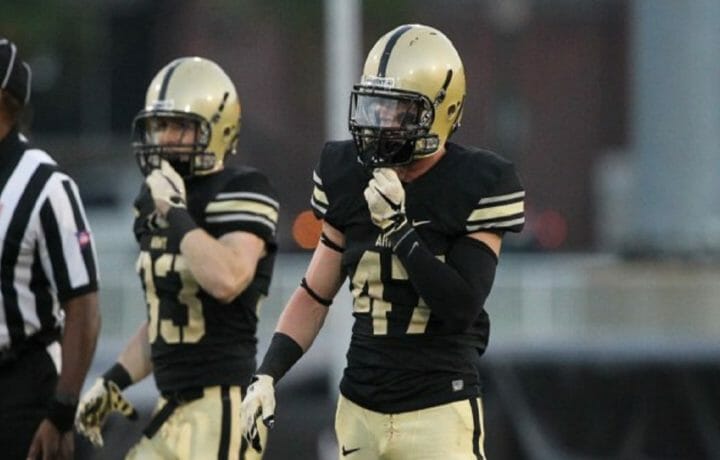The nation’s three main service academies at West Point, Annapolis, and Colorado Springs are among the hardest institutions of higher education to get in to. As much as ROTC guys like me like to mock my academy brothers, graduating from a service academy is a big deal. While the playing field has been leveled somewhat, academy grads still have a better chance of making the general and flag officer ranks than do officers commissioned through ROTC and Officer’s Candidate School.
The academies exist first and foremost to produce military leaders. So it is disappointing that the White House is considering giving elite athletes, who have studied at taxpayer expense to become officers, the formal opportunity to defer their military obligation to pursue a professional sports career.
President Donald Trump floated the idea during a Rose Garden ceremony on Monday a s he awarded the Army Black Knights with the Commander-in-Chief Trophy, presented to the service academy football team who wins the round-robin between the three academies. This is the second consecutive season where Army has won the trophy, a first in the school’s history.
“I hope it doesn’t become the story,” the president remarked, “but it is a big story, because I’m going to look at doing a waiver for service academy athletes who can get into to the major leagues — like the NFL, hockey, baseball. We’re going to see if we can do it.”
Lest you think that this means the athletes would be free of any obligation, he added, “And they’ll serve their time after they’re finished with professional sports.”
If this becomes the official policy (and as I’ve warned many times, the president saying or tweeting something doesn’t make it policy… yet) it will overturn the April 2017 policy established by former Secretary of Defense James Mattis. Mattis’s policy said that for two years after commissioning, “officers will serve as full-fledged military officers carrying out the normal work and career expectations of an officer who has received the extraordinary benefits of an ROTC or military academy education at taxpayer expense.”
Even more so than professional sports, war is a young person’s game. This is especially true in the Army. An Army lieutenant’s first job is usually platoon leader, a role that requires a fair amount of physical and mental stamina. While one can make the argument that if non-commissioned officers who move to the officer ranks can still do the job, then so can officers who took time off to play sports professionally, I’m not buying it.
Athletes who attend regular NCAA Division I schools (and even some who attend DII and DIII schools) naturally harbor the ambition to play professionally once they graduate, the only near-term ambition a senior at the service academies should have is to serve his or her country by leading troops. It’s a sacred obligation, one that isn’t to be entered into lightly.
There are right and wrong ways to mix sports and military service. In my humble opinion, men like Naval Academy graduates David Robinson (basketball), Napoleon McCallum (football), current New England Patriots long-snapper Joe Cardona, and Seattle Seahawks wide receiver Keenan Reynolds are doing it wrong. The Navy accommodated their professional sports careers by assigning them to jobs close to the teams who drafted them, or modifying their obligations.
In Robinson’s case, the Navy reduced his service obligation from five years to two. In McCallum’s case, he was permitted to play for two years but then deployed with the fleet in 1987, eventually returning to the NFL in 1990. Cardona served at the Naval Academy Preparatory School in Newport, R.I., about an hour’s drive from Gillette Stadium in Foxborough, Mass. for the first part of his NFL career. He has since transferred to the U.S. Navy Reserve. And I don’t believe Reynolds has ever served a day on active duty.
They still owe a debt to their country.
There are three outstanding examples of elite professional athletes who did it “the right way” and set an example for others.
NFL Hall of Famer and two-time Super Bowl champion Roger Staubach was also a standout at Annapolis, winning the Heisman Trophy and the Maxwell Award in 1963. After graduation in 1965, rather than pursue a job where he could play football immediately, Ens. Staubach instead deployed to Vietnam. He began his NFL career in 1969 and proceeded to pass for 22,700 yards and 153 touchdowns in his career.
Current Pittsburgh Steelers lineman Alejandro Villanueva, the son of a Spanish Naval officer, graduated from West Point in 2010. He served as an infantry officer in the 10th Mountain Division and the 75th Ranger Regiment, deploying to Afghanistan a total of three times before joining the NFL in 2014.
Lastly, not all standouts go pro. The Heisman Trophy and Maxwell Award winner for 1958 was a halfback for West Point named Pete Dawkins. After graduation in 1959, Dawkins studied as a Rhodes Scholar before embarking on his formal military career. He became an infantry officer, serving in Vietnam. He retired from the Army in 1983 at the rank of brigadier general.
That’s the definition of All-American.


